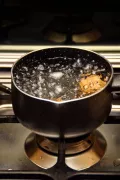Poaching is a cooking technique that can elevate any dish with its delicate and flavorful results. But even though poaching seems simple, it's easy to make mistakes that can ruin your dish. In this article, we'll guide you through the essential do's and don'ts of poaching food. From choosing the right liquid to avoiding overcooking, you'll discover the most common mistakes to avoid and tips to achieve the perfect poached dish every time.
The Basics of Poaching Food
Poaching involves cooking food in a hot liquid that is usually flavored with herbs, spices, and aromatics. The liquid should be at a low simmer, around 160°F to 180°F, depending on the type of food you're poaching. Here are some essential do's to keep in mind when poaching:
- Do choose the right liquid: The liquid you use for poaching should complement the food you're cooking. For example, you can poach fish in a court bouillon, which is a flavorful broth made with vegetables, white wine, and herbs. Poaching chicken, on the other hand, requires a light chicken broth or water.
- Do heat the liquid slowly: It's important to bring the liquid to a low simmer slowly. If the liquid boils, the food will cook unevenly and may become tough or rubbery.
- Do add flavorings: To enhance the flavor of the food, you can add herbs, spices, citrus, garlic, or other aromatics to the poaching liquid. This will infuse the food with subtle but delicious flavors.
- Do use a thermometer: Use a thermometer to ensure the poaching liquid stays at a consistent temperature. This will help you achieve perfectly cooked food every time.
The Don'ts of Poaching Food
While poaching is a simple technique, there are a few common mistakes that can ruin your dish. Here are some don'ts to avoid:
- Don't use too much liquid: Using too much liquid can dilute the flavor and texture of the food. Make sure the food is mostly covered by the liquid, but not swimming in it.
- Don't let the liquid boil: If the liquid boils, the food will cook unevenly, and the texture will become tough and rubbery.
- Don't overcook the food: Overcooked food can become dry and tough. Check the food frequently and remove it from the poaching liquid as soon as it's cooked to your desired doneness.
- Don't skip the seasoning: While the poaching liquid should be flavorful, it shouldn't be overly salty. However, a small amount of salt will enhance the flavor of the food.
Common Mistakes to Avoid When Poaching Specific Types of Food
Different types of food require different poaching techniques. Here are some common mistakes to avoid when poaching specific types of food:
- Eggs: Don't use boiling water for poaching eggs. The water should be at a low simmer, and you should add a splash of vinegar to help the egg whites coagulate. Don't swirl the water too aggressively or overcrowd the pan.
- Fish: Don't overcook fish. The poaching liquid should be at a low simmer, and the fish should be fully submerged in the liquid. Keep an eye on the temperature and cooking time to prevent overcooking.
- Chicken: Don't poach chicken for too long, or it will become dry and stringy. Chicken breasts should be poached for about 10-12 minutes, while whole chicken legs take around 20-25 minutes.
Poaching as a Creative Cooking Technique
Poaching is a versatile cooking technique that can be used in many different ways. Here are some creative ways to use poaching in your cooking:
- Poached fruit: Poached fruit makes a delicious and healthy dessert. You can poach pears, peaches, or apples in a sweet syrup flavored with cinnamon, vanilla, or star anise. Serve with yogurt or whipped cream.
- Poached chicken salad: Poached chicken makes a flavorful and healthy addition to a salad. Poach chicken breasts in a light chicken broth, and then shred the meat and toss it with greens, vegetables, and a light vinaigrette.
- Poached seafood: Poached seafood is a healthy and flavorful way to prepare fish, shrimp, or mussels. You can poach seafood in a light broth or wine, and serve it with a flavorful sauce or aioli.
Conclusion
In conclusion, poaching is a simple but elegant cooking technique that can elevate any dish. By following the essential do's and avoiding the don'ts, you can achieve the perfect poached dish every time. Whether you're poaching eggs, fish, or chicken, the key is to be patient, pay attention to the details, and use your creativity to explore new flavors and textures. We hope this article has inspired you to try poaching in your own kitchen and experiment with this versatile cooking technique.









